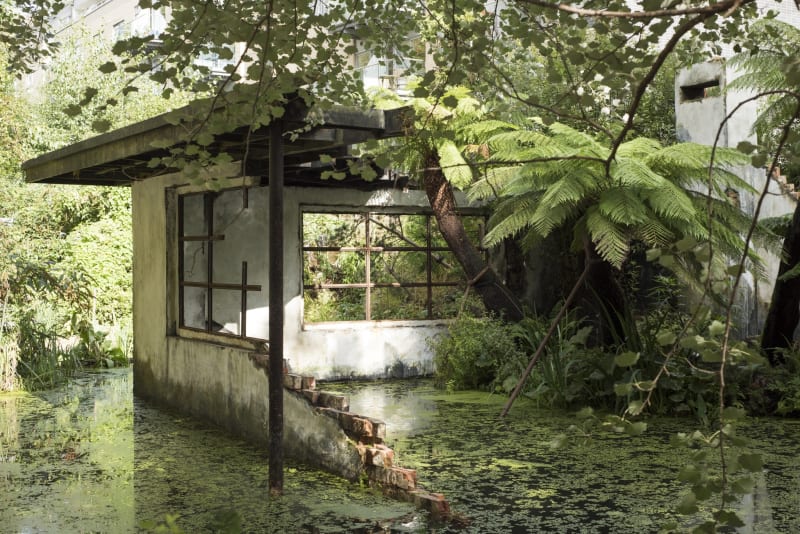Alex Hartley: After You Left
An exhibition of new work by the British artist, including a major architectural intervention in the gallery’s waterside garden.
Thoughts of modernism and its legacy, as well as Romantic ideas of the ruin and the picturesque are conjured in these new works. While modernist architecture has been a constant touchstone for Hartley, amplified in recent work is a sense of narrative, of the viewer having arrived at a situation of ambiguous cause and uncertain outcome.
Resembling an International Style domestic building apparently abandoned to the elements, the major architectural intervention A Gentle Collapsing II transforms the gallery’s waterside garden into a scene of poetic dereliction and decay. Built on the canal bank and into the water itself, the work encapsulates classic modernist tropes – the clean lines and horizontality of Bauhaus architecture as exported to the US by Mies van der Rohe in the 1930s and later exemplified by Philip Johnson and Richard Neutra, amongst others. Yet the structure and what it appears to portray – a home vacated without explanation, open to the elements, its white rendered walls peppered with black mould rising from the waterline – stands in stark contrast to images of domestic architecture and attendant aspirational lifestyles from the period. Instead, created especially for the garden, with its tree ferns suggestive of an ancient subtropical or temperate landscape, A Gentle Collapsing II looks to have undergone an accelerated process of ageing. It is as if we have been teleported into the future in order to look back at the present or very recent past.
The work offers poignant reflection on themes of entropy and decay. It is, in some ways, emblematic of a wider collapsing – of ideals or even spirit. Running contrary to such thoughts, however, is the undeniable aesthetic pleasure we find in ruins – their compelling, transportative quality. In this sense, A Gentle Collapsing II becomes a kind of time machine that frees the mind to wander, gently collapsing or dislocating a sense of linear time as it does so. The work chimes with the idea of the folly as a faux historical structure placed in the landscape to act as a conversation piece, with the real-life ruins that seduced aristocratic tourists on the Grand Tour in the eighteenth century, and with the tastefully timeworn abbeys and classical temples seen in works by JMW Turner, Francis Towne, John Sell Cotman and others.
A further collapsing occurs between genres. Hartley’s work always encourages us to consider how we experience and think about our constructed surroundings – through surface and line, scale and materials, locations and contexts. A Gentle Collapsing II breaks down rigid categories of production, referring as much to painting as to architecture, landscape design, sculpture or even theatre. Similarly, in a new series of wall-based works in which photographic, painterly and sculptural elements are brought together, the idea of the boundary – between interior and exterior, private and public space, manmade and natural environments, two and three dimensions, object and image – is subject to constant re-evaluation. Classic examples of modernist domestic architecture, photographed by Hartley in Los Angeles, form the basis of a series of monochrome wall-based works in which the photographic image and hand-painted elements – describing and embellishing the verdant West Coast landscape – are separated by a layer of semi-transparent Perspex. Caught up in these works are ideas of privacy and voyeurism, and the contradiction of modernist aspiration as epitomised by the glass-walled pavilion giving rise to the desire for boundaries of other kinds.
Comprising sculptural and photographic elements in which the supports of plinth and frame are merged, further large-scale works present fragmentary architectural details in front of dense jungle scenery. As with A Gentle Collapsing II, these works allude to the manmade world versus the natural environment. Narratives of entropy and decay are ever present. Yet, for Hartley, this is a surprisingly fertile territory, one that allows the imagination to roam freely, to envision what might have been and what might be to come.
Location
Victoria Miro Gallery I and Garden-

Alex Hartley is a recipient of the 2025 Paul Hamlyn Foundation Award
November 14 2025Alex Hartley has been named a recipient of the Paul Hamlyn Foundation’s 2025 Awards for Artists, the largest individual arts awards for visual artists and...Read More -

Alex Hartley speaks to Fakewhale
September 15 2025'I am aware of the presence of the viewer as the missing element in the work I make... I consciously leave space for them.'Read More
-

Alex Hartley’s new commission for the Royal Albert Memorial Museum, Exeter
October 19 2024The work is on view as part of Dartmoor: A Radical Landscape , a major group exhibition (19 October 2024–23 February 2025) exploring the region's...Read More -

Alex Hartley features in Decennium at Hestercombe Gallery
March 11 2024On view 23 March–7 July 2024, the exhibition reflects on a decade of making and showing through the work of over twenty artists. Showcasing some...Read More
-

Alex Hartley talks to Wallpaper* about his new exhibition Closer Than Before
May 10 2023‘I'm aware that it’s a triggering thing,’ Alex Hartley says, looking at the watermark that runs around the Victoria Miro Gallery in Venice. ‘I live...Read More -

Alex Hartley features in Watou 2022: Sense of Place
August 10 2022Alex Hartley is interested in facets of counterculture. His large-scale installations are sometimes presented as ruins where place, purpose and context intermingle. As an example...Read More
-

New commissions by Alex Hartley are featured in In Ruins at Witley Court
July 12 2019Presented by Meadow Arts, In Ruins (12 July-3 November 2019) looks at ideas of ruin and decay through installations, sculptures and other work set in...Read More -

Alex Hartley features in Where Function Ends: Responses to the Architecture of Sir Edwin Lutyens
July 10 2019To mark the 150th anniversary of the birth of Sir Edwin Lutyens, Hestercombe Gallery presents new work by three artists that responds to the legacy...Read More
-

Alex Hartley is featured in The Other Place at KØS, Denmark
April 12 2019The Other Place (12 April-15 September 2019) presents six key art projects that revolutionise our understanding of what public art can be, showing its constant...Read More -

Alex Hartley creates a major new work for Folkestone Triennial 2017
September 2 20172 September - 5 November 2017 Balanced on the cliff edge, next to an Iron Age site for the manufacture of querns (millstones) and the...Read More
-

Alex Hartley participates in the 2017 Yokohama Triennale
August 16 20174 August - 5 November 2017 Titled “Islands, Constellations and Galapagos”, the sixth edition of the Triennale explores ideas of connectivity and isolation. Alex Hartley...Read More -

City AM’s Steve Dinneen spends a week as caretaker at Alex Hartley’s The Clearing
May 30 2017Going off the grid: What I learned after a week without technology in an “apocalypse dome”. By Steve Dinneen 'Smartphones are the new cigarettes,” screams...Read More
-

The Clearing by Alex Hartley and Tom James featured on Front Row
March 23 2017Hartley and James discuss their collaborative artwork for Compton Verney, Warwickshire. Listen here . Read more about The Clearing here .Read More -

The Clearing by Alex Hartley and Tom James at Compton Verney
March 18 2017The Clearing (18 March - 17 December 2017) is a vision of the future in the grounds of Compton Verney Art Gallery and Park ....Read More
-

Alex Hartley in Transparency at Walker Art Gallery
March 10 201724 March - 18 June 2017 Can art help us to see things differently? This exhibition shows how artists in the past and present have...Read More -

Dezeen reviews Alex Hartley: After You Left
December 6 2016Modernist ruin in London canal provides a glimpse at an uncertain future. By Emma Tucker British artist Alex Hartley has installed this crumbling modernist ruin...Read More
-

Alex Hartley: After You Left is one of Louisa Buck's London exhibition picks
November 26 2016Alex Hartley: After You Left, Victoria Miro, Wharf Road (until 16 December) To my mind the best—and now most prescient—work of art to be associated...Read More -
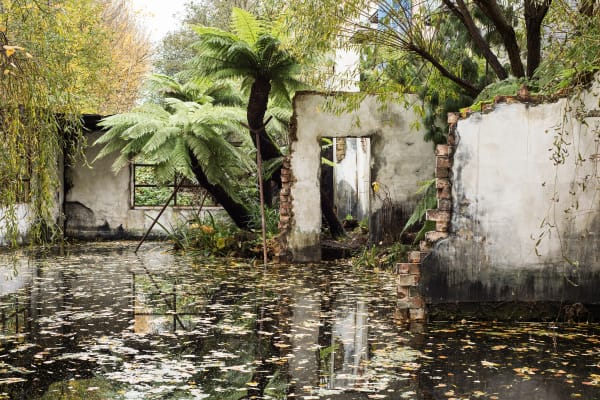
Time Out reviews Alex Hartley: After You Left
November 25 2016Alex Hartley: After You Left ★★★★ By Eddy Frankel There’s a house in ruins in a swamp. Palm trees sway as rain taps against their...Read More
-

Designboom looks at Alex Hartley's A Gentle Collapsing II
November 22 2016Alex Hartley erects a decaying, faux modernist ruin in a jungle-like London garden By Nina Azzarello In Victoria Miro Gallery’s waterside garden, artist Alex Hartley...Read More -
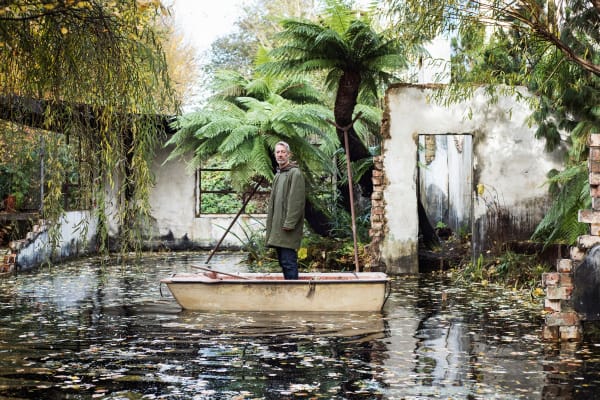
Alex Hartley exhibition featured in Wallpaper*
November 22 2016If we can count on anyone to wow us with spectacle it's British artist Alex Hartley. From the Arctic to outer space, it seems he...Read More
-
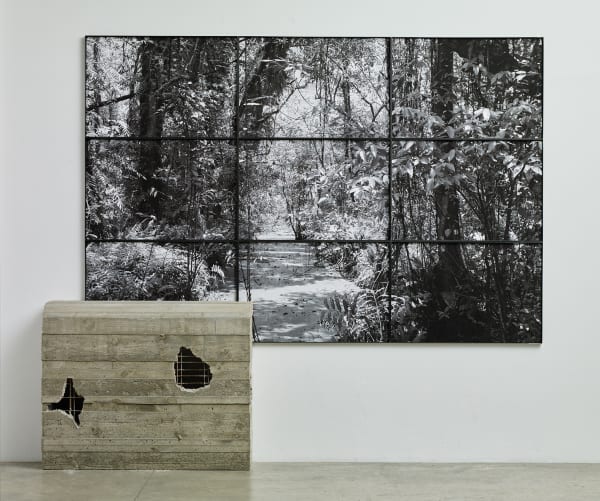
Alex Hartley discusses his new exhibition, and more, on Monocle Radio
November 22 2016Alex Hartley talks to Monocle Radio on the occasion of his new exhibition at Victoria Miro.Read More -
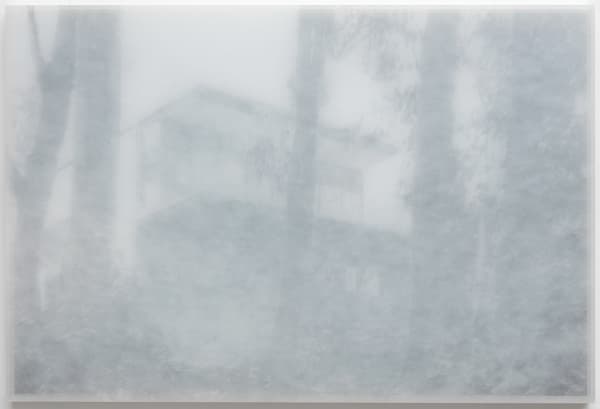
Alex Hartley talks to AnOther about his new exhibition, After Your Left
November 18 2016The Artist Constructing Modernist Ruins in a Gallery Garden For his enchanting new installation at London's Victoria Miro Gallery, opening this weekend, artist Alex Hartley...Read More
-

Alex Hartley discusses his new exhibition After You Left
November 18 2016Alex Hartley’s new exhibition After You Left features photography-based monochrome works depicting classic examples of mid-twentieth-century domestic architecture shrouded by foliage, a series of large-scale...Read More -
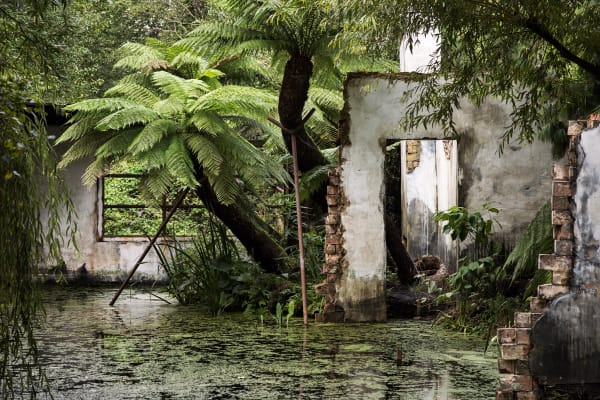
Alex Hartley interviewed in The Spaces about his new exhibition, After You Left
November 16 2016Artist Alex Hartley builds a Modernist ruin in a London gallery. By Cassie Davies Wedged into the bank of Victoria Miro Gallery’s waterside garden in...Read More
